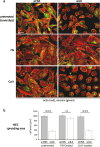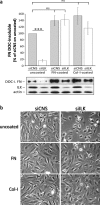ILK supports RhoA/ROCK-mediated contractility of human intestinal epithelial crypt cells by inducing the fibrillogenesis of endogenous soluble fibronectin during the spreading process
- PMID: 32183701
- PMCID: PMC7079544
- DOI: 10.1186/s12860-020-00259-0
ILK supports RhoA/ROCK-mediated contractility of human intestinal epithelial crypt cells by inducing the fibrillogenesis of endogenous soluble fibronectin during the spreading process
Abstract
Background: Fibronectin (FN) assembly into an insoluble fibrillar matrix is a crucial step in many cell responses to extracellular matrix (ECM) properties, especially with regards to the integrin-related mechanosensitive signaling pathway. We have previously reported that the silencing of expression of integrin-linked kinase (ILK) in human intestinal epithelial crypt (HIEC) cells causes significant reductions in proliferation and spreading through concomitantly acquired impairment of soluble FN deposition. These defects in ILK-depleted cells are rescued by growth on exogenous FN. In the present study we investigated the contribution of ILK in the fibrillogenesis of FN and its relation to integrin-actin axis signaling and organization.
Results: We show that de novo fibrillogenesis of endogenous soluble FN is ILK-dependent. This function seemingly induces the assembly of an ECM that supports increased cytoskeletal tension and the development of a fully spread contractile cell phenotype. We observed that HIEC cell adhesion to exogenous FN or collagen-I (Col-I) is sufficient to restore fibrillogenesis of endogenous FN in ILK-depleted cells. We also found that optimal engagement of the Ras homolog gene family member A (RhoA) GTPase/Rho-associated kinase (ROCK-1, ROCK-2)/myosin light chain (MLC) pathway, actin ventral stress fiber formation, and integrin adhesion complex (IAC) maturation rely primarily upon the cell's capacity to execute FN fibrillogenesis, independent of any significant ILK input. Lastly, we confirm the integrin α5β1 as the main integrin responsible for FN assembly, although in ILK-depleted cells αV-class integrins expression is needed to allow the rescue of FN fibrillogenesis on exogenous substrate.
Conclusion: Our study demonstrates that ILK specifically induces the initiation of FN fibrillogenesis during cell spreading, which promotes RhoA/ROCK-dependent cell contractility and maturation of the integrin-actin axis structures. However, the fibrillogenesis process and its downstream effect on RhoA signaling, cell contractility and spreading are ILK-independent in human intestinal epithelial crypt cells.
Keywords: Actin stress fibers; Cell contractility; Epithelial cells; Fibrillogenesis; Fibronectin; ILK; IPP complex; Integrin; RhoA; α5β1.
Conflict of interest statement
The authors declare no potential conflict of interest.
Figures









Similar articles
-
RGD-independent cell adhesion via a tissue transglutaminase-fibronectin matrix promotes fibronectin fibril deposition and requires syndecan-4/2 α5β1 integrin co-signaling.J Biol Chem. 2010 Dec 17;285(51):40212-29. doi: 10.1074/jbc.M110.123703. Epub 2010 Oct 7. J Biol Chem. 2010. PMID: 20929862 Free PMC article.
-
The fibronectin-binding integrins alpha5beta1 and alphavbeta3 differentially modulate RhoA-GTP loading, organization of cell matrix adhesions, and fibronectin fibrillogenesis.J Cell Biol. 2002 Dec 23;159(6):1071-86. doi: 10.1083/jcb.200205014. Epub 2002 Dec 16. J Cell Biol. 2002. PMID: 12486108 Free PMC article.
-
Integrin-linked kinase regulates integrin signaling in human trabecular meshwork cells.Invest Ophthalmol Vis Sci. 2011 Mar 25;52(3):1684-92. doi: 10.1167/iovs.10-6397. Print 2011 Mar. Invest Ophthalmol Vis Sci. 2011. PMID: 21071740 Free PMC article.
-
Fibronectin fibrillogenesis, a cell-mediated matrix assembly process.Matrix Biol. 2005 Sep;24(6):389-99. doi: 10.1016/j.matbio.2005.06.008. Matrix Biol. 2005. PMID: 16061370 Review.
-
The ins and outs of fibronectin matrix assembly.J Cell Sci. 2003 Aug 15;116(Pt 16):3269-76. doi: 10.1242/jcs.00670. J Cell Sci. 2003. PMID: 12857786 Review.
Cited by
-
Depleting RhoA/Stress Fiber-Organized Fibronectin Matrices on Tumor Cells Non-Autonomously Aggravates Fibroblast-Driven Tumor Cell Growth.Int J Mol Sci. 2020 Nov 4;21(21):8272. doi: 10.3390/ijms21218272. Int J Mol Sci. 2020. PMID: 33158289 Free PMC article.
-
Structural characterization of a polysaccharide from Qi-Gui herb pair and its anti-tumor activity in colon cancer cells.Front Pharmacol. 2025 Mar 24;16:1557151. doi: 10.3389/fphar.2025.1557151. eCollection 2025. Front Pharmacol. 2025. PMID: 40196375 Free PMC article.
-
Exploring the mechanism of fibronectin extra domain B in the tumor microenvironment and implications for targeted immunotherapy and diagnostics (Review).Mol Med Rep. 2025 Jun;31(6):160. doi: 10.3892/mmr.2025.13525. Epub 2025 Apr 11. Mol Med Rep. 2025. PMID: 40211711 Free PMC article. Review.
-
Fibrin(ogen) Is Constitutively Expressed by Differentiated Intestinal Epithelial Cells and Mediates Wound Healing.Front Immunol. 2022 Jun 22;13:916187. doi: 10.3389/fimmu.2022.916187. eCollection 2022. Front Immunol. 2022. PMID: 35812445 Free PMC article.
-
Cell migration guided by long-lived spatial memory.Nat Commun. 2021 Jul 5;12(1):4118. doi: 10.1038/s41467-021-24249-8. Nat Commun. 2021. PMID: 34226542 Free PMC article.
References
MeSH terms
Substances
Grants and funding
LinkOut - more resources
Full Text Sources
Miscellaneous

